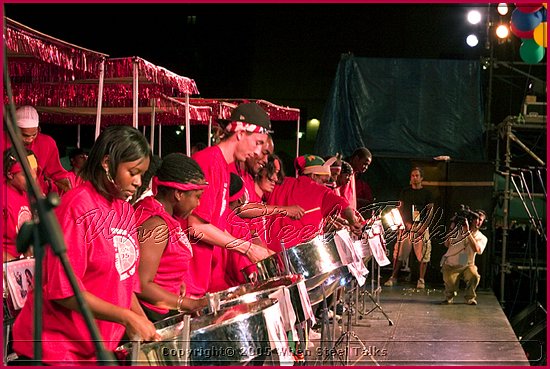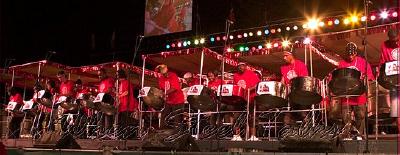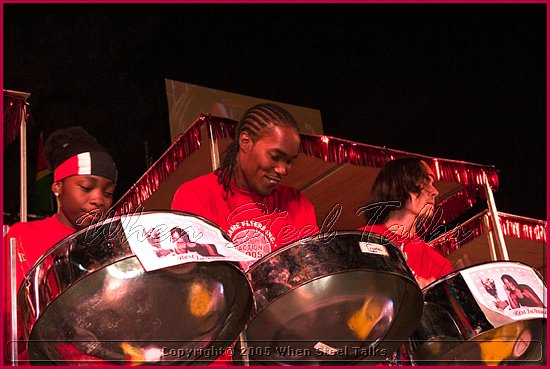|
New York 2005
Panorama
From the Inside
Anton Estaniel
Northern Illinois University
This August I spent
some time observing some of the different steel bands of Brooklyn for the
New York Panorama. I was struck at how much dedication the members had
towards perfecting their respective music.
 Dedication is the maxim of
Panorama. To me it is the most distinguishing characteristic for steel bands
that compete in Panorama. Rehearsals occur an average of five days a week
and often go into the wee hours of the night and early morning. The music is
learned by ear so initial rehearsals are dedicated to committing the
composition to memory. Once the music is learned the composition is drilled
in a seemingly interminable manner. The process of memorizing music and
rehearsing can seem lengthy and arduous, yet players come night after night
to work. Why is there such a strong commitment to play for this competition?
I suspect the reasons go beyond the thrills of performance and competition. Dedication is the maxim of
Panorama. To me it is the most distinguishing characteristic for steel bands
that compete in Panorama. Rehearsals occur an average of five days a week
and often go into the wee hours of the night and early morning. The music is
learned by ear so initial rehearsals are dedicated to committing the
composition to memory. Once the music is learned the composition is drilled
in a seemingly interminable manner. The process of memorizing music and
rehearsing can seem lengthy and arduous, yet players come night after night
to work. Why is there such a strong commitment to play for this competition?
I suspect the reasons go beyond the thrills of performance and competition.
The steel bands of Brooklyn are comprised mostly of children and young
adults; many of these children and young adults come from some type of
Trinidadian or Caribbean background. People of West Indian descent are a
well-established group in Brooklyn; this population acts as a feeder for the
bands in the area.
 Parents may have been pan players in the past or they may
be still active with the instrument in some way or form. But playing pan
goes beyond family inclination. The steel bands act as a link to Caribbean
culture. It maintains a connection for the multi-generational West Indian
population to their home cultures. It is a great tool for the purpose of
cultural faculty because it is one that requires avocation. Imagine that a
child is removed from his/her native Trinidadian culture, this person feels
a lack or no affinity to his/her parentís or grandparentís culture, this
despite living in the Caribbean neighborhood of Brooklyn. He/she enlists in
a steel band to learn pan and is put into an environment where a
representation of the culture is actively practiced and not just treated
casually. This creates potential for the child to further explore Caribbean
culture and cements a bond to a culture that may have seemed foreign. In
other words playing pan keeps Caribbean culture active, resonant, and
dynamic. Parents may have been pan players in the past or they may
be still active with the instrument in some way or form. But playing pan
goes beyond family inclination. The steel bands act as a link to Caribbean
culture. It maintains a connection for the multi-generational West Indian
population to their home cultures. It is a great tool for the purpose of
cultural faculty because it is one that requires avocation. Imagine that a
child is removed from his/her native Trinidadian culture, this person feels
a lack or no affinity to his/her parentís or grandparentís culture, this
despite living in the Caribbean neighborhood of Brooklyn. He/she enlists in
a steel band to learn pan and is put into an environment where a
representation of the culture is actively practiced and not just treated
casually. This creates potential for the child to further explore Caribbean
culture and cements a bond to a culture that may have seemed foreign. In
other words playing pan keeps Caribbean culture active, resonant, and
dynamic.
Young people drive panorama, so as a result the Brooklyn bands have all the
customary energy that young people provide. Case in point: Sesame Flyers. I
spent some time with Sesame Flyers this August and had the opportunity to
play percussion with them for Panorama.
 Like
any ensemble they were encountering some difficulties. The arrangement
wasnít being produced to its full capabilities for a number of reasons: the
tune that co-arrangers Andy Akiho and Freddie Harris III [arranged] was challenging and
some of the members had not yet learned their parts with only days [to go] before
Panorama. It also seemed that the grind of rehearsing was beginning to weigh
on the ensemble. Perhaps I was witnessing a lull but some of the playing
seemed flat and the mistakes were noticeable. I returned to the yard the
night before the competition to rehearse and the band had been turned
around. Iím sure there were mistakes during the run-throughs but they
werenít noticeable. Some of the musical details that Andy and Freddie had
been working on with the band were finally becoming audible. Most
importantly the energy that was lacking in earlier rehearsals was fully
present that evening. The yard was buzzing and the players were giving all
they could in the late hours of the evening. Granted it was the night before
Panorama so it was natural for excitement to be in the air, but it seemed
evident to me that the very young majority of the band was manifesting the
high energy. People were dancing as they played from run-through to
run-through, for hours on end. This type of wild enthusiasm doesnít occur
often with people who have been playing music for years upon years. How
often do you see an older musician get up on top of their bass pans and
dance during a jam section of an arrangement? Youth play pan (and have a lot
of fun doing it) and connect to it despite sometimes being generations
removed from Trinidad & Tobago. This is why people dedicate themselves to
the instrument and to Panorama. Like
any ensemble they were encountering some difficulties. The arrangement
wasnít being produced to its full capabilities for a number of reasons: the
tune that co-arrangers Andy Akiho and Freddie Harris III [arranged] was challenging and
some of the members had not yet learned their parts with only days [to go] before
Panorama. It also seemed that the grind of rehearsing was beginning to weigh
on the ensemble. Perhaps I was witnessing a lull but some of the playing
seemed flat and the mistakes were noticeable. I returned to the yard the
night before the competition to rehearse and the band had been turned
around. Iím sure there were mistakes during the run-throughs but they
werenít noticeable. Some of the musical details that Andy and Freddie had
been working on with the band were finally becoming audible. Most
importantly the energy that was lacking in earlier rehearsals was fully
present that evening. The yard was buzzing and the players were giving all
they could in the late hours of the evening. Granted it was the night before
Panorama so it was natural for excitement to be in the air, but it seemed
evident to me that the very young majority of the band was manifesting the
high energy. People were dancing as they played from run-through to
run-through, for hours on end. This type of wild enthusiasm doesnít occur
often with people who have been playing music for years upon years. How
often do you see an older musician get up on top of their bass pans and
dance during a jam section of an arrangement? Youth play pan (and have a lot
of fun doing it) and connect to it despite sometimes being generations
removed from Trinidad & Tobago. This is why people dedicate themselves to
the instrument and to Panorama.
About the
author...
California-native
Anton Estaniel currently attends Northern Illinois University,
Illinois, USA and is finishing his Masters in Music. The visit
to When Steel Talks studios, and his observation of the arrangers'
conference, feeds directly into his thesis. Generally speaking, the
thesis subject focuses on the roles played by various cultural activities
and organizations, including the steelbands - within the fabric of the
community in Brooklyn, New York, USA.
From the News Desk of
When Steel Talks
- |
 Like
any ensemble they were encountering some difficulties. The arrangement
wasnít being produced to its full capabilities for a number of reasons: the
tune that co-arrangers Andy Akiho and Freddie Harris III [arranged] was challenging and
some of the members had not yet learned their parts with only days [to go] before
Panorama. It also seemed that the grind of rehearsing was beginning to weigh
on the ensemble. Perhaps I was witnessing a lull but some of the playing
seemed flat and the mistakes were noticeable. I returned to the yard the
night before the competition to rehearse and the band had been turned
around. Iím sure there were mistakes during the run-throughs but they
werenít noticeable. Some of the musical details that Andy and Freddie had
been working on with the band were finally becoming audible. Most
importantly the energy that was lacking in earlier rehearsals was fully
present that evening. The yard was buzzing and the players were giving all
they could in the late hours of the evening. Granted it was the night before
Panorama so it was natural for excitement to be in the air, but it seemed
evident to me that the very young majority of the band was manifesting the
high energy. People were dancing as they played from run-through to
run-through, for hours on end. This type of wild enthusiasm doesnít occur
often with people who have been playing music for years upon years. How
often do you see an older musician get up on top of their bass pans and
dance during a jam section of an arrangement? Youth play pan (and have a lot
of fun doing it) and connect to it despite sometimes being generations
removed from Trinidad & Tobago. This is why people dedicate themselves to
the instrument and to Panorama.
Like
any ensemble they were encountering some difficulties. The arrangement
wasnít being produced to its full capabilities for a number of reasons: the
tune that co-arrangers Andy Akiho and Freddie Harris III [arranged] was challenging and
some of the members had not yet learned their parts with only days [to go] before
Panorama. It also seemed that the grind of rehearsing was beginning to weigh
on the ensemble. Perhaps I was witnessing a lull but some of the playing
seemed flat and the mistakes were noticeable. I returned to the yard the
night before the competition to rehearse and the band had been turned
around. Iím sure there were mistakes during the run-throughs but they
werenít noticeable. Some of the musical details that Andy and Freddie had
been working on with the band were finally becoming audible. Most
importantly the energy that was lacking in earlier rehearsals was fully
present that evening. The yard was buzzing and the players were giving all
they could in the late hours of the evening. Granted it was the night before
Panorama so it was natural for excitement to be in the air, but it seemed
evident to me that the very young majority of the band was manifesting the
high energy. People were dancing as they played from run-through to
run-through, for hours on end. This type of wild enthusiasm doesnít occur
often with people who have been playing music for years upon years. How
often do you see an older musician get up on top of their bass pans and
dance during a jam section of an arrangement? Youth play pan (and have a lot
of fun doing it) and connect to it despite sometimes being generations
removed from Trinidad & Tobago. This is why people dedicate themselves to
the instrument and to Panorama.